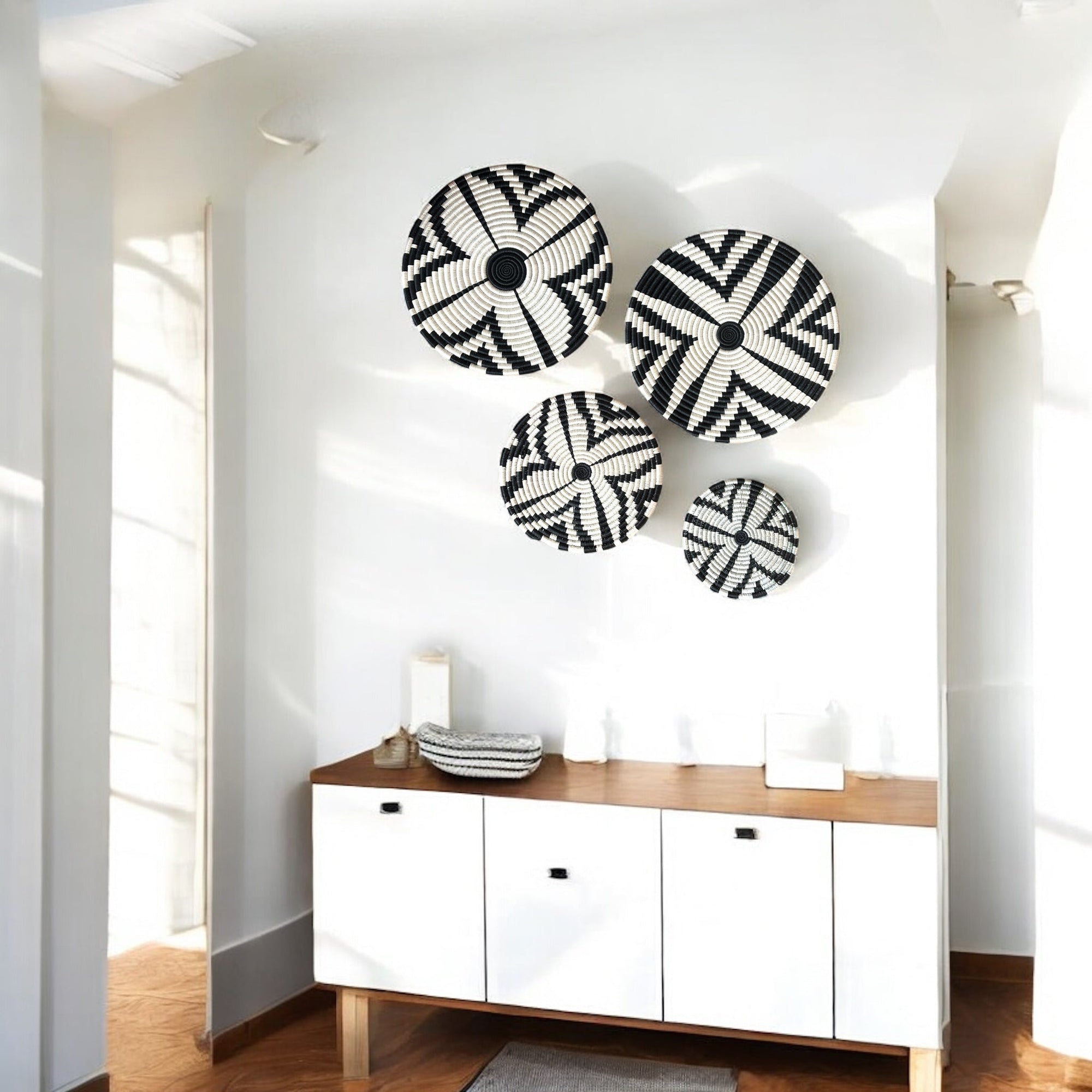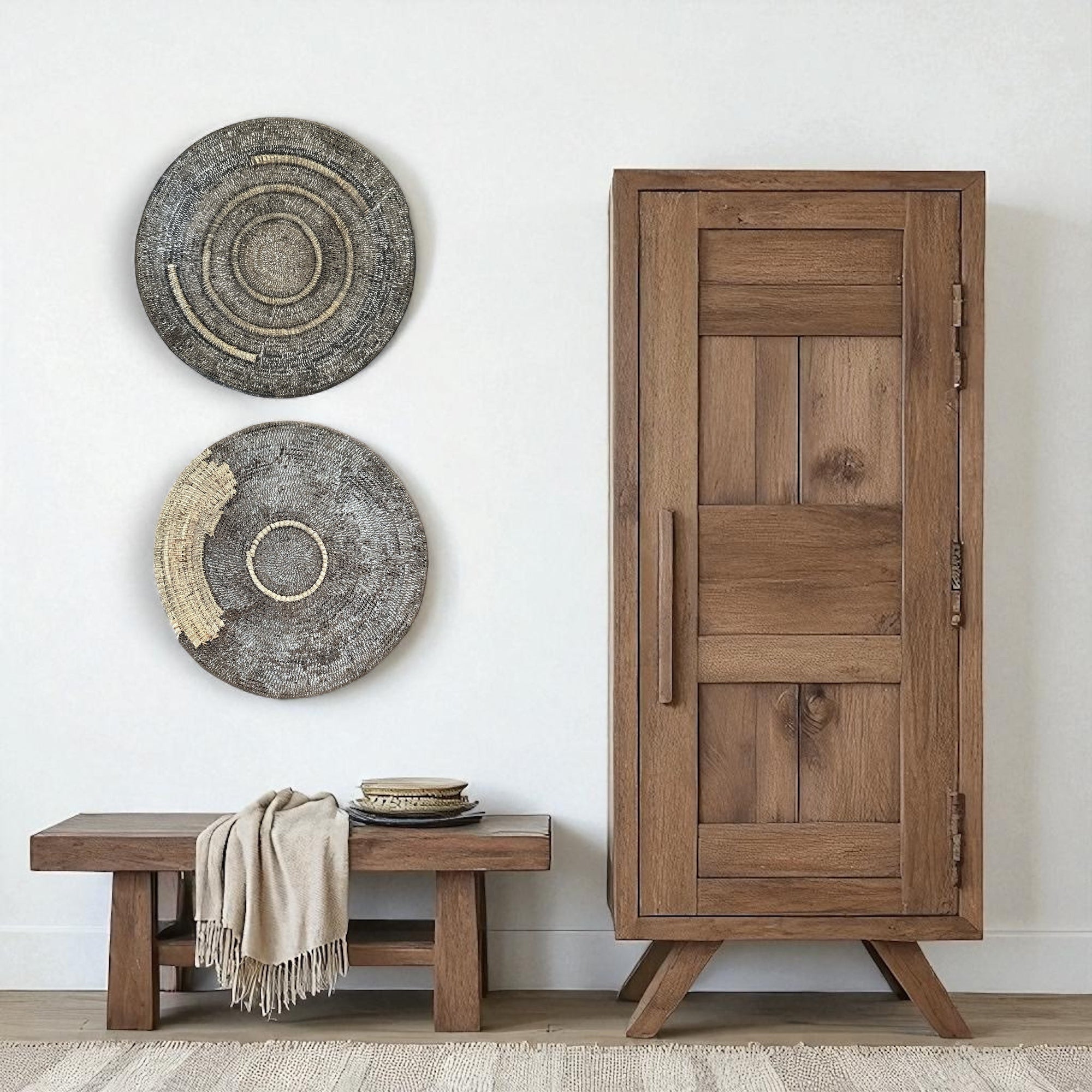Key Takeaways
- Wall art sets mood and flow: anchor large pieces to furniture and sightlines for balance.
- African textiles add texture and culture: frame kente, kuba, or shweshwe with UV-protection to preserve them.
- Follow easy proportions: art width should be 60–75% of the furniture below; gallery wall spacing around 5–8 cm.
- Balance colours with intent: earth tones paired with indigo accents feel modern and grounded.
- Mix formats: canvas wall art, framed prints, baskets, and textiles work together for depth.
- Care matters: dust gently, rotate delicate pieces, and keep lighting below 50 lux for textiles.
Why Wall Art Matters
A bare wall can make even a stylish room feel unfinished. Wall art isn’t just decoration; it’s what anchors a space, sets the mood, and tells a story. And when you bring African textiles into the mix, you’re not just filling empty space, you’re layering history, craftsmanship, and cultural depth into your home.
At Eya Home Living, we curate handcrafted wall art South Africa that blends authenticity with modern interiors. From bold kuba cloths to intricate beadwork, each piece is more than decor, it’s an expression.

What Counts as Wall Art?
Wall art spans far beyond paintings:
- Canvas wall art for living rooms - bold statements above sofas and feature walls.
- Framed wall prints - structured pieces for corridors or gallery layouts.
- Textile panels and tapestries - warm, tactile additions that soften modern spaces.
- Woven baskets and reliefs - sculptural elements that add contour.
Wall art serves three roles: it anchors scale, sets colour direction, and brings rhythm to a room. When chosen with intention, it transforms how a space feels, not just how it looks.
Why African Textiles Belong on Your Walls
African textiles carry story and craftsmanship in every weave. Whether it’s the geometric patterns of kente, the earthy texture of kuba cloth, or the familiar shweshwe print, each fabric ties your space to a broader heritage.
Instead of hiding them in cupboards, frame or hang these textiles as home wall art:
- Float frames highlight raw edges and seams.
- Shadow boxes protect embellishments and beading.
- Simple rods or mounts keep installation easy.
The result? A wall that feels alive, personal, and undeniably stylish.
Scale, Proportion, and Placement
Here’s where design meets simple maths:
- Art should span 60–75% of the furniture width beneath it (e.g., above a sofa or console).
- For gallery walls, keep 5–8 cm gaps between pieces to maintain rhythm.
- Hang artwork with centres at around 145 cm from the floor, the sweet spot for eye level.
Think of wall art like punctuation in a sentence: it gives rhythm, flow, and clarity.
Colour, Motif, and Mood
Colour sets the emotional tone of a room. African textiles offer a natural palette to play with:
- Earth neutrals (clay, beige, charcoal) — grounding and versatile.
- Indigo and rust — striking accents that feel bold but timeless.
- Geometric motifs (kente, kuba) — bring energy without overwhelming.
The trick? Limit yourself to 2–3 dominant motifs and let them guide your accessories — scatter cushions, rugs, or lampshades for cohesion.

Types of Wall Art for Every Space
- Living Room: A large canvas or textile panel above the sofa, flanked by smaller framed prints.
- Bedroom: Calm-toned wall hangings above the headboard.
- Home Office: Abstract wall paintings with restrained palettes to energise but not distract.
- Hallways or Staircases: Gallery walls with a mix of framed prints, textiles, and baskets.
Each format has a place, the magic lies in how you combine them.
Care and Longevity
Textiles and natural fibres need a little love:
- Light: Keep exposure under 50 lux; avoid direct sun.
- Humidity: Maintain stable indoor conditions (45–55% RH).
- Dust: Use a soft cloth or vacuum with a mesh screen.
- Rotation: Move delicate pieces every few months to extend life.
These aren’t high-maintenance rules, just practical steps to ensure your wall art ages as gracefully as it looks today.
Sustainable and Ethical Choices
Choosing African-inspired wall art supports not only your home’s aesthetic but also artisans and small-scale makers across the continent. Every handcrafted piece tells a story of heritage, technique, and community. At Eya Home Living, we prioritise authentic sourcing and sustainable materials, so your walls don’t just look good — they feel good too.
Frequently Asked Questions
-
Why use African textiles as wall art?
They bring warmth, cultural depth, and bold patterns while celebrating traditional craftsmanship. -
How do I choose the right size?
Aim for 60–75% of the furniture width beneath and keep the centre at 145 cm from the floor. -
What’s the best way to frame textiles?
Use float frames, shadow boxes, or rod hangers. For delicate fabrics, UV-protective glazing is recommended. -
Can African wall art work in modern homes?
Absolutely. Pair bold textiles with neutral furniture for balance, or mix them into gallery walls. -
What’s the easiest wall art to start with?
Smaller framed wall prints or woven baskets — simple, affordable, and versatile. -
How do I care for textile wall art?
Dust gently, avoid direct sunlight, and rotate sensitive pieces seasonally. -
Is wall art suitable for commercial spaces?
Yes. Our pieces add personality to hotels, cafes, and office spaces. -
How can wall art affect mood?
Textures and colours influence energy, earthy tones calm, bold prints energise. -
What if my walls are small?
Choose vertical panels or cluster smaller pieces for rhythm without crowding. -
Does Eya Home Living ship nationwide?
Yes, we deliver across South Africa, each piece packaged securely and ready to hang.
Final Word
Wall art shouldn’t be an afterthought. It’s the finishing touch that gives your home its personality. With African textiles, you’re not just decorating, you’re weaving culture, craft, and comfort into every corner.
At Eya Home Living, we make it simple to bring this story home. Explore our curated wall decor collection and let your walls speak with character and style.



